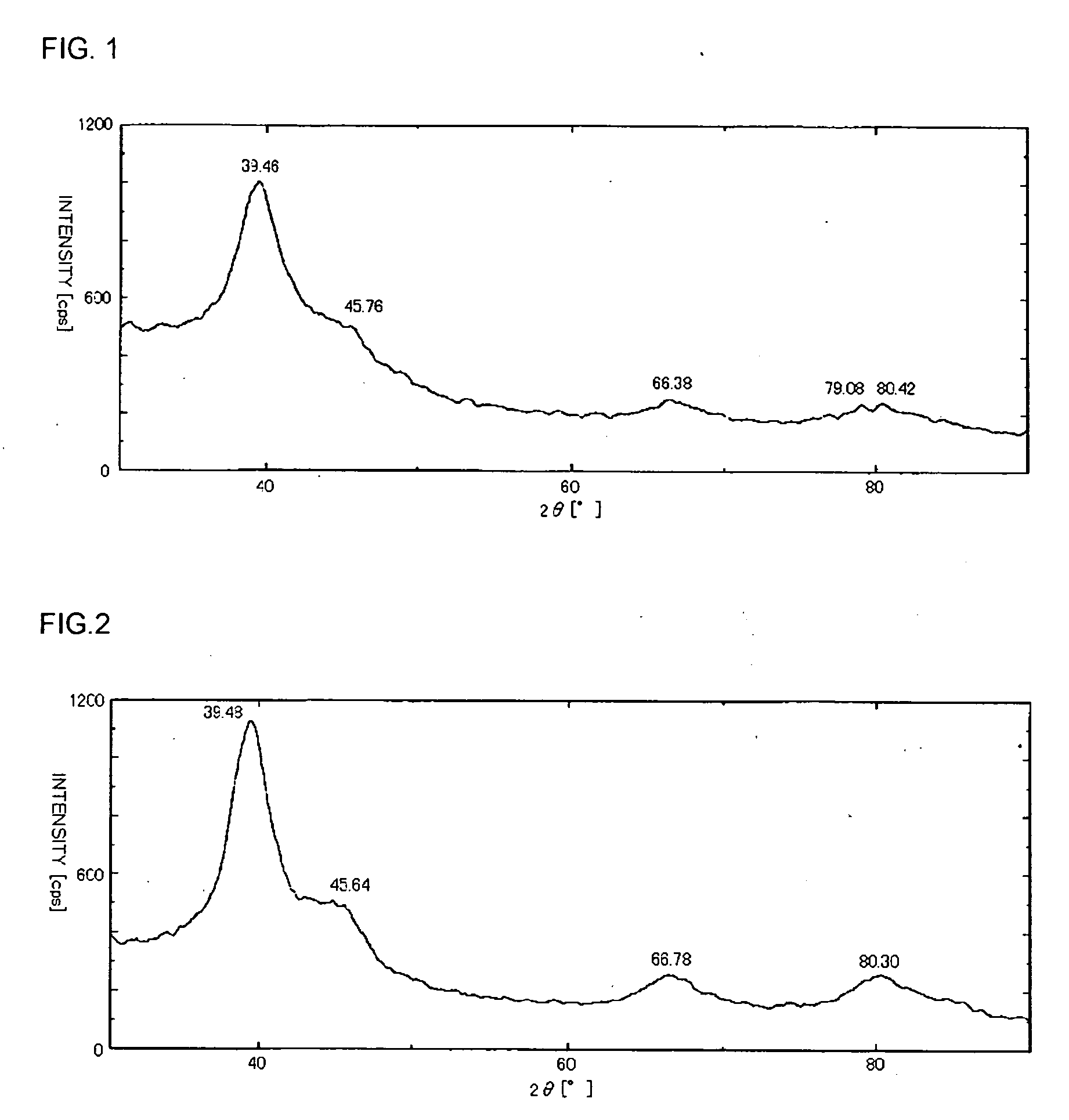Carbon-intersticed metallic palladium, palladium catalyst and method for preparation thereof, and method for producing alpha,beta-unsaturated carboxylic acid
a technology of metallic palladium and catalyst, which is applied in the direction of catalyst activation/preparation, metal/metal-oxide/metal-hydroxide catalyst, and metallic can solve the problem that the reaction performance of the palladium catalyst disclosed in the above-described documents is not sufficient in the case of use, and achieves high yield
- Summary
- Abstract
- Description
- Claims
- Application Information
AI Technical Summary
Benefits of technology
Problems solved by technology
Method used
Image
Examples
example 1
[0076] (Preparation of Carbon-Insertion-Type Palladium Metal)
[0077] 1.1 parts of palladium acetate (chlorine content of 62 ppm, made by Aldrich Co.) were added as the palladium compound to 62.0 parts of a 92 wt % aqueous n-valeric acid solution as the solvent, and were heated and dissolved at 80° C. The obtained solution was left to stand at the room temperature, and brought and sealed in an autoclave having a stirring device. A rotation number was set to 1200 rpm, the stirring was started, and introduction and discharge of a nitrogen gas were repeated several times to replace the inside of the autoclave with nitrogen. Thereafter, a propylene gas was introduced at 0.6 MPa (gauge pressure), and the temperature was raised to 50° C. by a heater and held for one hour.
[0078] Thereafter, the autoclave was cooled to 20° C. by an ice bath, the gas in the autoclave was discharged, and subsequently the autoclave was opened. The reaction solution in the autoclave was transferred into a centr...
example 2
[0084] A carbon-insertion-type palladium metal was prepared in the same manner as in Example 1 except that 1.0 part of palladium acetate (chlorine content 80 ppm, made by Tanaka Kikinzoku Kogyo K.K.) was used as a palladium compound and 150 parts of a 93 wt % aqueous n-valeric acid solution were used as a solvent. The amount of inserted carbon in the obtained carbon-insertion-type palladium metal was 0.32 mol with respect to 1.0 mol of the palladium metal, and the crystal face distance of the (111) face of the palladium metal calculated from the diffraction angle measured by the XRD was 2.281 Å (2θ=39.48°). It is to be noted that the obtained XRD chart is shown in FIG. 2.
[0085] A performance of a palladium catalyst was evaluated in the same manner as in Example 1 except that the carbon-insertion-type palladium metal was used as the palladium catalyst. As a result, the methacrolein conversion was 86.4%, the selectivity of methacrylic acid was 72.5%, the selectivity of the polymer / ol...
example 3
[0086] The carbon-insertion-type palladium metal prepared by the procedure of Example 1 was scattered in 50 parts of an 85 wt % aqueous acetic acid solution, and further 5.0 parts of activated carbon (specific surface area; 840 m2 / g, pore volume; 0.42 cc / g, average pore diameter; 2.0 nm) were added and stirred at 20° C. for one hour. The obtained dispersion was filtered with suction under a nitrogen flow to obtain an activated carbon-supported palladium catalyst. A palladium loading ratio of the activated carbon-supported palladium catalyst was 10 wt %.
[0087] The performance of the palladium catalyst was evaluated in the same manner as in Example 1 except that 5.5 parts by weight of the activated carbon-supported palladium catalyst were used as the palladium catalyst, and 150 parts of a 75 wt % aqueous acetic acid solution containing 200 ppm of p-methoxy phenol were used as the solvent of the liquid-phase oxidation. As a result, the methacrolein conversion was 85.3%, the selectivit...
PUM
| Property | Measurement | Unit |
|---|---|---|
| Temperature | aaaaa | aaaaa |
| Fraction | aaaaa | aaaaa |
| Substance count | aaaaa | aaaaa |
Abstract
Description
Claims
Application Information
 Login to View More
Login to View More - R&D
- Intellectual Property
- Life Sciences
- Materials
- Tech Scout
- Unparalleled Data Quality
- Higher Quality Content
- 60% Fewer Hallucinations
Browse by: Latest US Patents, China's latest patents, Technical Efficacy Thesaurus, Application Domain, Technology Topic, Popular Technical Reports.
© 2025 PatSnap. All rights reserved.Legal|Privacy policy|Modern Slavery Act Transparency Statement|Sitemap|About US| Contact US: help@patsnap.com


